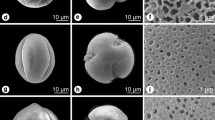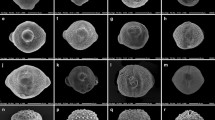Abstract
Phylogenetic analyses based on morphology placeAnaxagorea and other taxa with granular monosulcate pollen, as in otherMagnoliales, at the base ofAnnonaceae. Taxa with columellar tetrads, granular tetrads, and inaperturate monads form a derived clade. To test the systematic importance of palynology, we analyzed the data set with pollen characters removed. The result was lower resolution and a different rooting of the family, betweenUvariopsis and other groups with columellar tetrads.Anaxagorea and other monosulcates are higher in the tree, implying that granular monosulcate pollen, laminar stamens, and irregular endosperm ruminations are reversals. This rooting is highly unparsimonious when pollen characters are included, and only weakly supported over theAnaxagorea rooting when pollen is excluded. Together with preliminary molecular analyses, these experiments confirm the special value of palynology in systematics ofAnnonaceae.
Similar content being viewed by others
References
Chatrou, L., 1997: Preliminary remarks on the subdivision ofMalmea. — Annonaceae Newslett.11 (in press).
Donoghue, M. J., Doyle, J. A., 1989: Phylogenetic analysis of angiosperms and the relationships ofHamamelidae. — InCrane, P. R., Blackmore, S., (Eds): Evolution, systematics, and fossil history of theHamamelidae,1, pp. 17–45. — Oxford: Clarendon Press.
Doyle, J. A., Le Thomas, A., 1994: Cladistic analysis and pollen evolution inAnnonaceae. — Acta Bot. Gallica141: 159–170.
—, 1995: Evolution of pollen characters and relationships of AfricanAnnonaceae: implications of a cladistic analysis. — InLe Thomas, A., Roche, E., (Eds): 2e Symposium de palynologie africaine, Tervuren (Belgique), pp. 241–254. — Orléans: Centre International pour la Formation et les Echanges Géologigues.
—, 1996: Phylogenetic analysis and character evolution inAnnonaceae. — Bull. Mus. Natl. Hist. Nat., B, Adansonia18: 279–334.
—, 1994: Integration of morphological and ribosomal RNA data on the origin of angiosperms. — Ann. Missouri Bot. Gard.81: 419–450.
Fries, R. E., 1959:Annonaceae. — InMelchior, H., (Ed.): Die natürlichen Pflanzenfamilien17aII, pp. 1–171. 2nd edn. — Berlin: Duncker & Humblot.
Hesse, M., Morawetz, W., Ehrendorfer, F., 1985: Pollen ultrastructure and systematic affinities ofAnaxagorea (Annonaceae). — Pl. Syst. Evol.148: 253–285.
Johnson, D. M., Murray, N. A., 1995: Synopsis of the tribeBocageeae (Annonaceae), with revisions ofCardiopetalum, Froesiodendron, Trigynaea, Bocagea, andHornschuchia. — Brittonia47: 248–319.
Le Thomas, A., 1980–1981: Ultrastructural characters of the pollen grains of AfricanAnnonaceae and their significance for the phylogeny of primitive angiosperms. — Pollen& Spores22: 267–342,23: 5–36.
—, 1996: Implications d'une analyse cladistique dans l'histoire géographique desAnnonaceae: famille d'Angiospermes primitives. — InGuillaumet, J. L., Belin, M., Puig, H., (Eds): Phytogéographie tropicale, réalites et perspectives, pp. 171–180. — Paris: ORSTOM.
—, 1974: Quelques types de structure grenue dans l'ectexine de pollens simples d'Annonacées. — Compt. Rend. Hebd. Séances Acad. Sci., Sér. D278: 1187–1190.
—, 1976: De la structure grenue à la structure columellaire dans le pollen des Annonacées. — Adansonia15: 543–572.
—, 1994: Pollen ultrastructure and relationships ofFusaea (Baillon)Safford andDuguetia A. Saint-Hilaire (Annonaceae). — Rev. Palaeobot. Palynol.83: 55–64.
Maddison, D. R., 1991: The discovery and importance of multiple islands of most-parsimonious trees. — Syst. Zool.40: 315–328.
Maddison, W. P., Maddison, D. R., 1992: MacClade: analysis of phylogeny and character evolution, version 3. — Sunderland, Mass.: Sinauer.
Morawetz, W., 1986: Systematics and karyoevolution inMagnoliidae:Tetrameranthus as compared with otherAnnonaceae genera of the same chromosome number. — Pl. Syst. Evol.154: 147–173.
—, 1988: Karyosystematics and evolution of AustralianAnnonaceae as compared withEupomatiaceae, Himantandraceae, andAustrobaileyaceae. — Pl. Syst. Evol.159: 49–79.
Nowicke, J. W., Skvarla, J. J., 1979: Pollen morphology: the potential influence in higher order systematics. — Ann. Missouri Bot. Gard.66: 633–700.
Sanderson, M. J., Donoghue, M. J., 1989: Patterns of variation in levels of homoplasy. — Evolution43: 1781–1795.
Swofford, D. L., 1990: PAUP: phylogenetic analysis using parsimony, version 3.0. — Champaign, Ill.: Illinois Natural History Survey.
Van Heusden, E. C. H., 1992: Flowers ofAnnonaceae: morphology, classification, and evolution. — Blumea, Suppl.7: 1–218.
Van Setten, A. K., Koek-Noorman, J., 1992: Fruits and seeds ofAnnonaceae. Morphology and its significance for classification and identification. Studies inAnnonaceae XVII. — Biblioth. Bot.142: 1–101.
Van Zuilen, C. M., 1996: Patterns and affinities in theDuguetia alliance (Annonaceae). Molecular and morphological studies. — Doctoral Thesis, Utrecht University.
Waha, M., 1985: Ultrastruktur und systematische Bedeutung des Pollens beiBocageopsis, Ephedranthus, Malmea undUnonopsis (Annonaceae). — Pl. Syst. Evol.150: 165–177.
—, 1988: Different origins of fragile exines within theAnnonaceae. — Pl. Syst. Evol.158: 23–27.
—, 1988: Pollen evolution and systematics inAnnonaceae with special reference to the disulcate Australian endemic genera. — Pl. Syst. Evol.161: 1–12.
Walker, J. W., 1971: Pollen morphology, phytogeography, and phylogeny of theAnnonaceae. — Contr. Gray Herb.202: 1–131.
—, 1975: The bases of angiosperm phylogeny: palynology. — Ann. Missouri Bot. Gard.62: 664–723.
Author information
Authors and Affiliations
Additional information
This paper is dedicated to emer. Univ.-Prof. DrFriedrich Ehrendorfer on the occasion of his 70th birthday
Rights and permissions
About this article
Cite this article
Doyle, J.A., Le Thomas, A. Significance of palynology for phylogeny ofAnnonaceae: Experiments with removal of pollen characters. Pl Syst Evol 206, 133–159 (1997). https://doi.org/10.1007/BF00987945
Received:
Revised:
Accepted:
Issue Date:
DOI: https://doi.org/10.1007/BF00987945




